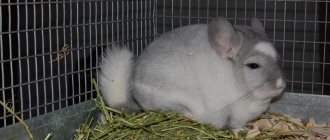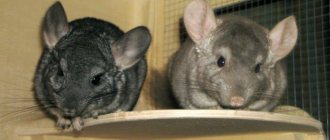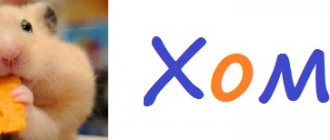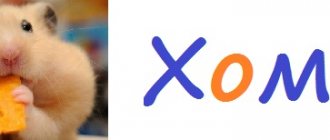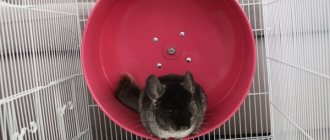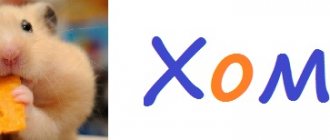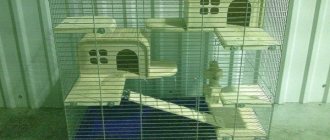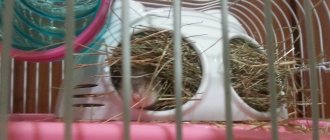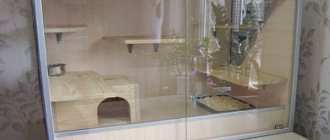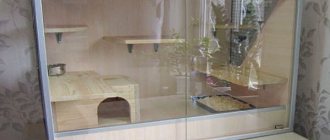- home
- Chinchilla
03/30/2019 Caring for a pet includes arranging its home with maximum comfort. It is very important for a chinchilla to have a cozy home in its cage.
The animal doesn't care what the house looks like. He needs to have a comfortable and safe place for rest and privacy. Therefore, it is necessary to find a reasonable balance between comfort for the animal and aesthetics for its owner.
Chinchilla house: purpose and installation
A chinchilla house has several purposes. During the day, the animal hides in it so that no one can disturb its sleep. Females absolutely need such a structure in order to breed offspring and take care of the cubs.
Install it in the farthest corner of the cage. It is advisable that there be twilight there. This way, a nocturnal animal will sleep more peacefully.
The house is installed permanently and firmly on the bottom of the cage. If you decide to attach it to the bars of the cage or raise it on a stand, you need to think about secure fastening. When the house falls, it will cause great stress and possible injury to the animal.
How to choose the right house size
Chinchillas differ in size, habits and individual needs. Few people know that chinchillas prefer to live without neighbors. The desire to communicate with relatives is clearly manifested only during the period of sexual hunting.
How to choose the right house size:
- Focus on your pet's habits - for secretive chinchillas, it is better to equip several small houses at once.
- The house should not be too big, but the chinchilla should be able to turn around in it.
Note! If several chinchillas live in a cage, each of them should have at least one house.
The minimum recommended cage size for a chinchilla is 1.2 x 1.2 x 0.9 m. To increase the living area, a crossbar for the second floor is installed in the cage. If your pet's cage meets the minimum requirements, you can purchase a ready-made house.
Types, shapes and types of houses for chinchillas
What types of houses for chinchillas can you find: made of wood, ceramics and plastic, straw and even twine. The last two options are chewed by chinchillas in a few weeks. In this regard, wooden ones will last longer.
The configurations of the houses are round, triangular, oval and rectangular. Projects in the form of wooden huts, medieval castles, and Indian wigwams look interesting.
You can choose any model based on financial availability and ideas about aesthetics. There are several criteria that must be adhered to:
- sizes are selected depending on the size of the chinchilla;
- the structure should not have holes or other places where a rodent’s paw could get stuck;
- In addition to the entrance, it is necessary to provide a window for ventilation;
- the most convenient for cleaning is the design without a bottom;
- The flat roof of the house is safe, from which the pet cannot fall;
- There should be no protruding nail heads, burrs or other dangerous protruding elements on the walls.
The corner design of the shelter looks compact and cozy and fits well into the interior of the animal’s home. The corner area in a chinchilla cage is psychologically associated with protection. That's why? Your pet will definitely like this project.
When a couple lives in a cage, there are two options: put one spacious house with two entrances or two nearby. The choice depends on the characters of the pets and the degree of their affection for each other. If you notice that even if there are two shelters, they tend to fit into one, you need to meet your friends halfway and put up one house of normal size.
If the chinchilla’s cage is small, it is worth considering the option of a house that is attached to the outside, therefore saving space in the animal’s home. The freed up area can be allocated for a play area.
Original ideas
Creative furry pet owners are offering interesting ideas on how to create a multi-functional home. So one of them is a house combined with a hayfield: shelter - once, chewing material - two, space for hay placed between the sticks - three. To make such a product, you need a minimum amount of materials:
- board as a roof,
- Dry birch or hazel sticks (due to the density of this type of wood, the chinchilla will chew them longer),
- board to hold them in place
- small screws, screws or nails for the same purpose.
In its finished form, the house looks like a beautiful and quite cozy rodent hut.
A special “biting” house for your pet can be made from branches and wood scraps, attaching them with the same fasteners.
Below are drawings of cottages - several options.
Single-family homes are also an economical option. If you build a whole cage or display case for chinchillas with your own hands, then its total price will be many times lower than the store price. So, dear masters, the puzzle is in your hands!
House for a chinchilla made of wood: advantages and disadvantages
The most common are wooden structures. They are inexpensive, sold everywhere, and come in a wide variety of shapes and sizes. It is possible to choose between single-story and multi-story options. A house for a chinchilla looks interesting with balconies, verandas, and stairs that give them a cozy look.
Wood products have their advantages:
- availability and variety of models, you can choose the design you like;
- low price, which saves money;
- easy to clean (just wipe with a damp cloth once a week);
Disadvantages of such products:
- animals may chew on the structure and you will have to change the house for another;
- if the chinchilla decides to mark the house, he will quickly and persistently absorb all the smells;
- the structures are light and there is a danger of them being thrown over;
- If the wooden house is varnished or glued with toxic glue, the chinchilla can get severe poisoning if it starts gnawing on it.
Before installing a wooden product into a cage, you need to make sure that all its components are carefully sanded. Otherwise, the rodent risks damaging its coat.
When an animal refuses to enter such a dwelling, there is no need to insist, but rather check for toxic resins that can emit an unpleasant odor.
Why do chinchillas need a wheel?
It is used both as a toy to help pass time and as a training device to prevent muscle atrophy. Increasingly, owners are purchasing these products just for added entertainment for their pet, without considering the real needs and required functionality of their pet.
Since each of the above options has a large number of disadvantages, we will consider a self-made wheel for chinchillas and determine the necessary tools and materials.
You will need:
- teachings;
- Crosshead screwdriver;
- electric jigsaw.
- Tension bearing from the Volga (can be purchased at an auto parts store);
- M12 screws - 2 pcs. (short);
- 7 bolt washers and 4 nuts;
- drill 12 mm;
- small screws - approx. 50 pcs. (length no more than 3 cm);
- Plywood - 2 pieces 8-12 mm thick, square sheets;
- wooden profiles - 5 pcs. (length 1 m).
Start by preparing the table. You need to place an unnecessary base - chipboard, fiberboard or cabinet doors. Using a drill, make a hole in this base that will later be used to secure the plywood.
Next, screw the self-tapping jigsaws to the base, having previously made a hole where the saw will come from. The distance between the hole made by the drill and the hole under the saw will determine the diameter of the circle. In our case it is 15 cm.
Important: The board used as a base must be long enough and placed on stable supports. It cannot be screwed on.
- Before you begin, remove the jigsaw to help you get the job done. Then draw two lines, longitudinal and transverse, on the plywood sheets to find the center where the hole should be drilled.
- Make a hole on the plywood sheet with an electric jigsaw at a distance of 15 cm from the center. On another sheet, make two holes: one at a distance of 15 cm from each other, the other at a distance of 12-13 cm from each other.
- Then attach the single pass sheet to the base using a short bolt, nut and washer. Tighten until the sheet can be rotated. Flip the base plate over to attach the jigsaw. Then turn it over again so that the attached plywood is on top and the screwed jigsaw is on the bottom. Plug the device into the outlet and make sure it is securely attached.
- Then start the jigsaw and slowly turn the plywood in a circle. The result should be a circle with a smooth edge. Unplug the machine, remove the wheel, remove the jigsaw and repeat with another piece of plywood.
- In the second case, we first get a circle, and then a thin circle, the thickness of which is equal to the distance between the holes made under the jigsaw.
- Next we move on to doing the circle steps that will connect circle to circle to form a circle. Take the wood sections and then cut them into equal lengths. The length of the segments determines the depth of the circle, so the reference point is the thickness of the rodent's body. In our case, the length of the wooden segments is 15 cm.
- The next step is to varnish all the woodwork, then air dry and ventilate it to completely remove the odor.
- Screw the wooden circle to the base, then position it vertically to make it easier to screw the wooden segments together. Then attach each wood block first to the circle and then to the perimeter. The end result should be a circle with a completely smooth inner surface and a ladder structure on the outside.
- As a final step, insert a bolt and washer from inside the center hole of the wheel that will be used to secure the wheel to the cage wall. From the outside, screw the nut onto the bolt. Then install the tension bearing on the cage and insert the screw into it. The wheel should rotate easily and quietly.
This is the end of the production process. If you want to make a wheel with a foot, then simply take two wooden boards, connect them perpendicular to each other, and then attach the moving part.
It is very interesting to look at the running wheel and, probably, every owner will want to buy such a toy for their chinchilla. But is a chinchilla necessary? How useful is this? Or do wheels harm a chinchilla's health?
Let me start by saying that not all chinchillas love wheels. There are chinchillas that do not run on wheels at all, and there are also those that do not want to get out of them. Wheels certainly have their advantages. The undoubted advantage of the wheel is that it allows you to keep your muscles in good shape; physical activity is beneficial for chinchillas.
When choosing a wheel, pay attention to its size. Running in a wheel with a small diameter is harmful to the health of a chinchilla. The minimum wheel size for chinchillas is 32 centimeters, but for some larger chinchillas this is not enough.
Of course, if we have the opportunity, it is better to choose a wheel with a diameter of 40 centimeters, but it is impossible to find such a wheel in stores. But craftsmen who make custom-made furniture for chinchillas can help you.
One of the most common options is plastic wheels. In my opinion, they are the safest of those sold in stores. However, they are also the most expensive.
Read also: Disinfectants for forests: what types of animals clean the environment.
Wheels with metal bars and mesh can be traumatic for chinchillas. One careless movement and the result is a broken paw or finger. To prevent this, they are lined with thick denim, and the sharp edges of the metal parts are sanded.
Be careful, some types of wheels may not harm the chinchilla running in them, but the chinchilla that may be in the wrong place at the wrong time. Therefore, when choosing a wheel, think about how safe it is, how it is mounted in the display case, and so on.
When choosing wooden models, consider the nature and purity of your chinchilla. Some chinchillas may use them in their litter boxes, and because wood absorbs moisture..... From there it's all clean.
The most ideal option, in my opinion, would be a durable aluminum wheel with a diameter of 40 cm. Such a wheel can be ordered in the USA. But this wheel also has a drawback - the price. Not everyone can afford it, but nothing is too expensive for chinchillas.
And finally, I want to tell you about the catwalks. This is the one I've been using lately. It's safe and convenient. My plate is made of plastic, but there are also aluminum running plates on the market. This is the preferred option, but.....
Chinchillas are very active rodents that prefer an active lifestyle to a calm one. Especially if the owner has fun with them: he invents entertainment and builds various toys for chinchillas. Read more about them below.
You can find many different pet rings on the shelves of pet stores. They differ in color, shape, material and, of course, price. The cheapest are accessories made of plastic, then metal and wood. Rarely, but nevertheless, there are products made of plexiglass and ceramics. However, such accessories for pets are many times more expensive.
Sports equipment for your pet can be made from almost any material. However, when choosing a base, it is important to consider that each of them has its own advantages and disadvantages.
Table 1: Materials for corresponding chinchilla rollers
| Type of material | Characteristics |
| Plastic products are the best option for rodents. Chinchillas do not bite it, which means that the device will last a long time. You can't get hurt on a plastic steering wheel. In addition, the running wheel made of this material is very light and can be easily removed and disinfected. And in stores this device is relatively inexpensive. However, plastic wheels are not without their drawbacks - their size is mainly suitable for small animals or chinchillas: adults are unlikely to fit in them. | |
| Tree | A wooden ring is a good option for rodents. The design is made from environmentally friendly material and has no honeycombs or sharp edges, meaning there is minimal risk of injury. However, wooden products also have their drawbacks: wood quickly absorbs moisture and dirt and therefore quickly deteriorates. It is almost impossible to clean the wheel of feces and urine, so you will have to put up with the unpleasant odor coming out of the “trainer”. The tree also attracts rodents as a treat - they will nibble on the wheel rather than ride in it. |
| Metal | Metal wheels are not a solid material, but a mesh product - this makes the structure lighter. However, this makes the wheel traumatic: very often small paws, hair or claws get caught in the holes. Therefore, many owners of these wheels try to protect their pets by wrapping the inside of the wheel with a thick material (such as denim) that will prevent little paws from getting through the holes while running. |
Regardless of whether you decide to buy a ready-made wheel or make it yourself, it is important that it is, above all, of good quality. The requirements for products intended for use on animals are as follows:
- All parts of the wheel must be smooth and even. No chips, sharp edges or cracks are allowed;
- the wheel should be light so that it does not run over the animal in case of a coup;
- It is better to clean the wheel material from paint and varnish;
- The size of the circle should be one and a half times larger than the chinchilla;
- If the wheel is made of metal, then a grid or horizontal bars made of wood or aluminum should be placed on the running surface;
- It is best to install the wheel on the wall rather than on the floor. If the exercise machine is installed at the bottom of the cage, one chinchilla may hit the spinning wheel while running and injure itself.
Ceramic house for a chinchilla: pros and cons
A ceramic house can not be found very often, since the required dimensions for a chinchilla cannot always be found on sale. Usually they look like fairy-tale castles and towers. Structures in the shape of a pumpkin or mushroom look very attractive.
The advantages of such products:
- very aesthetic appearance, such a home can become a worthy interior decoration;
- ceramic products are much heavier than wooden ones and are more difficult to turn over;
- Rodents do not damage such structures with their teeth, so they will last longer;
- baked clay is a material that washes well;
Inside such a structure, it is convenient for the animal to hide from the heat in the summer, since it is always cool there, but this factor can also be attributed to the disadvantages of a cold room in the winter.
There are also a number of disadvantages:
- clay products for animals are rare and difficult to find in pet stores;
- ceramics are not cheap materials, so you will have to pay a lot of money for such an accessory;
- If fired clay is covered with a poor-quality glaze, it will emit toxic fumes.
Ceramic must be handled with care as it can easily break.
Other materials for houses
There are interesting designs on sale made of durable plastic that are resistant to the teeth of rodents. They can have various shapes, often bright and attractive in appearance. They are easy to wash and clean. You should ask the seller for an environmental certificate for such products. Plastic is lightweight, so you need to immediately make sure that the structure is equipped with the ability to attach to walls or to the bottom.
There are cozy options made of nylon, folding out like a tent, with insulation and fur lining. The tent can not only be wiped, but also washed using baby or laundry soap.
The glass house for a rodent is easy to clean, it is environmentally friendly, but cold and uncomfortable for the pet.
Chinchillas love the shelter of their logs in the form of tunnels. They have good sound insulation, retain heat and are environmentally friendly. True, it is short-lived, because the rodent can gradually taste it.
As a good alternative to solid wood, there are plywood apartments, which can be of any configuration, bringing the ideas of creative designers into reality.
There is no need to confuse shelters for rest and containers for carrying animals. They have different purposes and designs.
Static toys
These games can also be classified as indoor games because they are more like furniture in your pet's home than toys. However, they allow you to keep your pet active at the proper level.
Shelves are a versatile exercise machine for rodents with weak front legs and strong back legs. Thanks to them, the animal can quickly jump and change position. The optimal shelf height is 80 centimeters. The animal can easily reach it and will not be injured if it falls. Plus, a shelf is a good way for rodents to sharpen their teeth.
You can also prepare the shelf yourself:
- Choose a small wooden board of any size (for example, 40x20 cm);
- Rinse thoroughly and scald with boiling water to get rid of parasites;
- Allow the product to dry completely;
- Sand the board so that there are no scratches, sharp corners or rough edges;
- fix it.
Place ledges throughout the cage at different levels to allow the animal to jump up and down.
Cascade of shelves
Tunnels
Fluffy loves to hide in pipes of different diameters, crawl along them and run after himself. The tunnels can be of any size, but at least 30-40 centimeters in diameter, so that the animal does not get stuck inside.
The tunnels are mainly made of plastic and wood, and the second option should have an iron frame to prevent the chinchilla from biting the edge. Some manufacturers offer a whole network of plastic tunnel passages that can be disassembled and assembled into any shape.
Translucent plastic is recommended as a material: your pet will feel safe there. You will always be able to find a rodent that has just fallen asleep inside the simulator without having to worry about it being stuck there.
Sticks and ladders
A simple wooden stick placed in a cage is just as amazing for tails because they can roll, chew and climb on it (if placed between the floor and shelf). The ladder is a modernized version of the stick that performs similar functions.
Sometimes rodents use it as a device to scratch their back - just place it vertically against the wall of the cage.
Read more: New developments in the field of beekeeping: technologies and techniques, video
Hammocks
When you place this device in the cage, you will see how much your chinchilla will love it. In this mini-bed you can not only relax, but also swing from side to side, like a swing.
Most commonly used materials:
- Tree;
- thick fabric;
- flexible but durable plastic.
In addition, hammocks can be single-level or two-level (tubular). The second option gives more options. In case of danger and when it is cold, the animal hides inside. In summer, the pet is cooled from above.
Sewing a hammock at home
Among the many types of hammocks that you can create with your own hands, it is better to choose a classic one, especially if you do not have enough handicraft practice. You will need:
- 2 pieces of heavy denim or fleece fabric measuring 45x45 cm;
- thread roller;
- adhesive tape;
- Needles;
- Scissors.
DIY chinchilla house
If you make a house for a chinchilla with your own hands, you can be sure of the safety of the chosen material and make a unique product according to your own sketch.
Materials and tools to prepare:
- wooden blanks 15 mm thick;
- fastening elements for furniture (dowels);
- grinding machine or sandpaper;
- wood hacksaw;
- ruler (tape measure) and pencil;
- electric drill.
Before you start work, you need to make drawings of the house on a sheet of paper. This is especially true for complex multi-story structures. If the house is small and simple, it is enough to adhere to the required dimensions, which are immediately marked on wooden blanks.
Requirements for the house
The main requirements for a future shelter for a pet are as follows:
- Maintain minimum dimensions of 30x20x20 cm (for one animal).
- Safety and ease of cleaning.
- Make the roof flat without slopes so that the animal can use it for rest.
- If the apartment is installed on a hill, it must be securely secured to avoid injury to the animal.
- When making a house, you cannot use toxic adhesives, varnishes and paints.
To make a shelter for a rodent, clean and high-quality timber or plywood is used.
Making a simple wooden structure
Step-by-step steps for making a wooden structure measuring 35x25x25 cm without a bottom:
- Apply markings to the workpieces.
- Cut out the walls and roof with a hacksaw.
- Mark the entrance on the front wall and windows on the side walls.
- Cut out the entrance hole and windows along the outlined contours.
- Sand the edges of the resulting parts.
- Drill holes in the walls and roof for furniture dowels.
- Fasten the walls and roof.
- Disinfect the product with a cloth moistened with water and alcohol.
- After drying, place the product in the cage.
To extend the durability of the product, the edges of the house parts can be covered with metal plates. Branch food and hay should always be present in the cage.
Implementation of a two-story project
A multi-level project is easy to implement from two or three sections, made according to the principle of a one-story house. Sections can be made in different sizes. They are fastened together with dowels or self-tapping screws. The ladders are made of wood.
How to make an arched mold
To make an arch-shaped house for a chinchilla, you will need:
- plywood sheet 20 mm thick;
- planks 30 mm wide and 20 mm thick;
- ruler and compass;
- jigsaw;
- sander;
- electric drill;
- furniture dowels.
How it's done:
- On a plywood sheet, use a compass to draw a circle with a radius of 15–17 cm.
- A circle is cut out with a jigsaw and cut into two equal parts, which will serve as the front and back walls.
- Mark and cut out an entrance for the animal and a window on the front wall.
- All edges of the parts are carefully polished.
- Cut and sand slats 25 cm long.
- Using an electric drill, drill holes in the slats and along the circumference of the walls at a distance of 30 mm.
- Fasten the prepared parts.
You cannot varnish or paint a wooden house. A few grams of the chemical is enough for a chinchilla to become poisoned, even to death.
Useful tips
Not all types of wood are suitable for making shelters for chinchillas. You cannot use material from stone fruit trees (cherries, plums, apricots), conifers (pine, larch, juniper, cedar and fir). Oak, beech, acacia and chestnut are not suitable. You can take apple, aspen, linden and poplar. Oak boards contain tannins that are harmful to the animal.
Some animals create a resting area with hay or straw. This should not be prevented. An old home from another animal causes a negative attitude in rodents. It should be freed from foreign odors and only then given to the rodent. If your pet ignores a gift, there are good reasons for this.
The most common:
- too small;
- lumber has a foreign odor;
- inconvenient design.
To make it convenient to keep order in a rodent’s bedroom, make a removable wall, a roof, or choose a design without a bottom.
How to equip a house inside
After purchasing or making a shelter, many owners are puzzled by the question of how to equip the house inside. Experienced chinchilla owners advise abandoning the idea of equipping the inside of the house. Provide this care to your pet; if he has enough hay and bedding, he will equip himself a nest in which he will feel comfortable.
If the house is new and the pet refuses to enter it, it is recommended to fill the bottom with filler from the cage. Don't worry if the chinchilla ignores the shelter for several days, the pet just needs time to learn the new accessory.
Advice: be patient and do not insist that the chinchilla go to the new house. Violent methods will result in the pet refusing to use the shelter.
